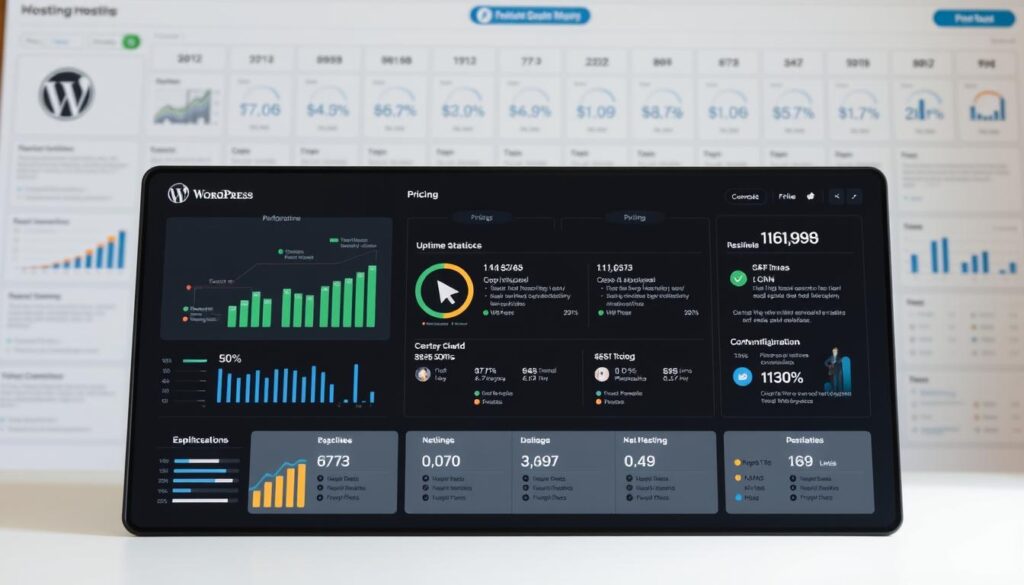Choosing the right platform for a website is a critical decision. With WordPress powering over 43% of all sites globally, the selection of a service provider directly impacts success. This analysis offers a deep dive into the performance of leading services.
Our evaluation is based on rigorous, real-world testing. We have continuously monitored 17 different providers since 2020. The data presented here focuses on the most current information from the first half of 2025.
The testing methodology measures what truly matters for a smooth user experience. Key metrics include Time To First Byte (TTFB), uptime reliability, and load test response times. This 24/7 monitoring provides insights beyond simple marketing claims.
This comparison previews services like WP Engine, GreenGeeks, Hostinger, Cloudways, Kinsta, and Bluehost. The goal is to deliver factual data collected over extended periods, helping you make an informed choice for your online presence.
Overview of Top WordPress Hosting Providers Compared (Speed & Uptime)
Our ongoing analysis scrutinizes the performance of 17 leading service providers to deliver unbiased insights. All services undergo identical testing conditions for a fair and accurate comparison.
The evaluation focuses on three critical metrics that directly impact site visitors. These measurements provide a complete picture of real-world performance.
- Time To First Byte (TTFB): This measures initial server response speed.
- Uptime Percentage: This indicates the reliability and consistency of a service.
- Load Test Results: These show how servers handle sudden traffic spikes.
Current data highlights several standout performers. WP Engine demonstrates strong overall reliability. GreenGeeks offers excellent value for multi-site projects at $2.96 monthly. Hostinger provides an affordable entry point at $2.99 per month, with both boasting 99.99% uptime.
The analysis weighs recent Q1-Q2 2025 data most heavily to reflect current capabilities. This approach, combined with historical tracking since 2020, ensures recommendations are timely and relevant.
Editor’s Choice awards add further validation. SiteGround earned the 2025 award for Best Web Host Overall. Hostinger received the Best Value Web Host award the same year.
Fast loading times and consistent availability are not just technical stats. They are essential for keeping visitors engaged and achieving online goals. This comparison relies solely on objective performance data collected through continuous monitoring.
Understanding Speed and Uptime Metrics
Digital success hinges on understanding the core measurements that define web performance. These metrics separate exceptional service from average offerings.
Load Test Insights and TTFB
Time To First Byte (TTFB) measures server responsiveness in milliseconds. It tracks the delay between a user request and the first data byte received. Faster TTFB creates better perceived site speed.
Response time benchmarks help evaluate server performance:
- Excellent: Under 200 milliseconds
- Good: 200-500 milliseconds
- Poor: Over 500 milliseconds
Load testing simulates real traffic spikes. This reveals how infrastructure handles sudden visitor surges during promotions or viral content.
Reliability Scores and Average Uptime
Uptime percentages translate to practical downtime expectations. A 99.90% guarantee means approximately 8.76 hours of annual downtime. The superior 99.99% level reduces this to just 52 minutes per year.
Consistent performance matters more than peak results. Providers like SiteGround and Hostinger maintain 99.99% reliability across seasons. This stability directly impacts user experience and search rankings.
Shared environments often show more variability than managed solutions. Understanding these differences helps make informed hosting decisions.
Key Features and Hosting Options
Understanding the complete package of features helps website owners select the ideal service provider. Different hosting options come with varying levels of support and specialized tools.
Managed WordPress and Free SSL Benefits
Managed WordPress services handle technical maintenance automatically. They perform CMS updates, plugin updates, and theme updates without user intervention.
These specialized platforms offer WordPress-optimized server configurations. They include staging environments for testing changes before going live.
Free SSL certificates come standard with quality services. They provide encrypted data transmission and boost SEO rankings. The browser padlock icon builds visitor trust.
Security Enhancements and Backups
Advanced security features protect websites from multiple threats. These include custom firewalls, DDoS protection, and malware scanning.
Providers like SiteGround offer proprietary security tools. Their Security Optimizer plugin simplifies advanced protection strategies.
Regular backups ensure data safety. SiteGround provides daily automated backups with 30-day retention. Hostinger offers weekly backups on entry plans and daily options on higher tiers.
These managed services save time and reduce technical expertise requirements. They provide peace of mind for site owners.
Comparing Hosting Plans and Pricing

Cost analysis reveals significant differences between promotional rates and long-term service expenses. Understanding these variations helps website owners make informed financial decisions for their online presence.
Initial promotional pricing often appears very attractive. SiteGround offers plans starting at $3 per month, while Hostinger provides similar entry-level pricing. These introductory rates typically apply to specific contract lengths.
Renewal rates tell a different story. SiteGround’s $3 monthly plan jumps to $18 upon renewal. Hostinger’s $3 plan increases to $11 after the initial four-year term. Some providers like Nexcess maintain consistent pricing without renewal increases.
Contract requirements vary significantly between services. Hostinger typically requires four-year commitments for best pricing. SiteGround uses one-year terms, while others offer month-to-month flexibility.
Value analysis considers both features and long-term costs. Budget-conscious users may prefer Hostinger’s stable pricing structure. Those seeking premium features might choose Nexcess at $16 monthly.
Smart budgeting requires calculating total expenses over multiple years. Attractive introductory rates can mask higher long-term costs. Understanding the complete pricing lifecycle ensures sustainable financial planning.
Evaluating Customer Support and Service
Beyond server performance metrics, the human element of customer service deserves careful evaluation. When technical issues arise, quality assistance becomes critical for maintaining website operations.
Different providers offer varying levels of customer support. SiteGround provides multiple contact methods including phone, live chat, and support tickets. Their staff receives extensive training in WordPress solutions.
Response time varies significantly between providers. SiteGround’s support teams have won multiple Stevie awards for their quick service. They often resolve CMS-specific issues within minutes.
Hostinger relies primarily on live chat with AI-powered initial responses. During peak times, wait periods can exceed 30 minutes to reach human representatives. This delay affects problem resolution time.
Nexcess offers 24/7 support through multiple channels. However, phone access proved problematic during testing periods. Their comprehensive approach includes email and ticket submission options.
WordPress expertise separates basic support from specialized service. True WordPress experts understand theme conflicts and plugin issues. They provide optimization strategies beyond basic troubleshooting.
Self-service resources complement direct support. Bluehost’s WordPress academy helps beginners learn website building. Extensive tutorial libraries often resolve issues without contacting support teams.
Quality customer support ensures smooth website operations. The right service provider combines quick response times with deep technical knowledge.
Exploring Security Features in WordPress Hosting

Protecting digital assets requires specialized security measures tailored to specific platform vulnerabilities. Popular content management systems face constant threats that demand robust protection systems.
Foundation security begins with SSL certificates that encrypt data transmission. Firewall protection filters malicious traffic before it reaches the site. These basic measures create essential baseline security for any online presence.
Advanced protection goes beyond standard features. SiteGround implements a custom firewall designed specifically for WordPress attack patterns. Their proprietary anti-bot system claims to block millions of daily threats.
Security plugins add significant value to hosting packages. Nexcess includes Solid Security Pro, a $99 plugin providing brute force protection and malware scanning. SiteGround offers their Security Optimizer plugin for implementing advanced strategies.
Vulnerability scanning identifies potential weaknesses before exploitation. Hostinger’s WordPress-specific scanner checks for outdated plugins and themes with known security issues. This proactive approach prevents many common attacks.
DDoS protection safeguards sites against distributed denial-of-service attacks. Both Hostinger and Nexcess provide this critical feature to maintain availability during traffic surges.
Backup systems serve as final security layers. SiteGround offers automated daily backups with 30-day retention. Hostinger provides weekly backups on entry plans and daily options on higher tiers.
Brute force protection prevents automated login attempts targeting admin passwords. These comprehensive security features work together to create a protected environment for any site.
Performance Reviews from Latest Q1-Q2 2025 Testing
Fresh data from the first half of 2025 provides a clear snapshot of current capabilities. This performance review focuses exclusively on results gathered between January and June.
The testing methodology ensures fairness. Identical test sites were deployed across all 17 providers. These sites are monitored continuously, 24/7, 365 days per year.
Key metrics include Time To First Byte (TTFB), uptime percentages, and load test response times. This approach delivers an apples-to-apples comparison.
Real-World Load Test Results
Simulated traffic spikes reveal how each server handles pressure. The results separate resilient infrastructure from less capable options.
SiteGround achieved a perfect 100% uptime during the testing week. Its average site speed remained within the recommended three-second maximum.
Hostinger exceeded its 99.9% uptime guarantee. It delivered the second-fastest server speed among all tested hosts.
GreenGeeks continues to offer impressive reliability. It maintains 99.99% uptime at an affordable $2.96 per month.
Nexcess demonstrated excellent site speed without optimizing its performance tools. This suggests significant potential for even faster results.
These findings are based on the last testing update from October 22, 2025. They represent the most current performance data available.
User Experience and Ease of Setup

The initial interaction with a hosting platform sets the tone for the entire website management journey. Providers that simplify this process remove significant barriers for newcomers.
Different companies approach the onboarding experience with unique strategies. Some focus on guided installation, while others emphasize educational resources.
Guided Installation and Setup Processes
SiteGround offers a comprehensive guided installation that helps users select appropriate themes and essential plugins. This approach simplifies the often overwhelming initial setup for a new website.
Hostinger provides a similar guided process with their site assistant tool. This makes the installation particularly easy for first-time website owners.
Bluehost takes an educational approach with their WordPress academy. This beginner-friendly resource teaches users how to build their sites step by step.
DreamHost offers a unique professional website building service. Customers can have experts create complete sites within 24 hours based on their specifications.
The dashboard interface significantly impacts ongoing management. Hostinger’s intuitive account dashboard and server management tools received specific praise during testing.
Visual page builders enhance the creation experience. Elementor’s drag-and-drop interface provides a user-friendly alternative to standard editing tools for creating page layouts.
These setup tools and processes demonstrate how providers prioritize user experience. They transform technical complexity into accessible steps for any skill level.
Assessing Renewal Pricing and Long-term Costs
Renewal rates often present a significant financial surprise for those who focus solely on introductory pricing. Many providers offer attractive initial rates that increase dramatically when the first contract term ends.
SiteGround’s lowest-tier plan jumps from $3 per month to $18 monthly upon renewal. This represents a 500% price increase. Their highest-tier plan reaches $45 per month after the first year.
Hostinger offers $3 monthly pricing with a four-year commitment, renewing at $11 per month. Their one-year discount option costs $4 monthly versus the four-year $3 rate. This demonstrates how contract length affects the total cost.
Nexcess maintains consistent pricing with no renewal increases. Their plans range from $4 to $16 monthly on three-year terms. This transparent approach provides better long-term value despite higher initial rates.
Bluehost Starter increases from $1.99 to $9.99 monthly upon renewal. DreamHost Shared Starter goes from $4.95 to $10.99 after the first three months. Elementor Host Cloud rises from $8.99 to $14.99 monthly.
Smart budget planning requires calculating expenses based on renewal rates rather than promotional pricing. Setting calendar reminders before renewal dates helps evaluate alternatives. Some providers allow negotiation or migration to new promotional rates.
Long-term contracts like Hostinger’s four-year term offer better pricing but reduce flexibility. Understanding these trade-offs helps website owners make informed financial decisions for sustainable online presence.
Impact of Free Domain and Added Extras

Bundled extras and complimentary services often determine the real value proposition of different hosting solutions. These included features can significantly impact the total cost of website ownership.
A free domain for the first year is commonly offered with many hosting plan options. This benefit typically saves $10-$15 initially. However, the domain must be renewed at standard rates after the first year.
Email hosting varies dramatically between providers. Some budget plans exclude email entirely, requiring separate purchases. SiteGround includes professional email across all tiers, while Hostinger offers it as a limited trial.
Backup services also differ significantly. SiteGround provides daily backups as permanent included features. Hostinger offers weekly backups on entry-level plans with daily options on premium tiers.
Proprietary tools add substantial value. SiteGround’s performance and security plugins would require third-party purchases elsewhere. Nexcess includes premium plugins like Solid Security Pro, worth $99 separately.
Higher-tier plans often include AI-powered extras. Hostinger’s Business and Startup plans feature AI content generators, image creators, and SEO tools. These can reduce dependency on external services.
Understanding what’s permanently included versus temporary trials helps avoid surprise charges. The true value of any hosting plan depends on how these extras align with specific website needs.
Optimizing for WordPress: Tools and Integrations
Specialized integrations separate premium services from standard offerings. These built-in tools provide immediate performance benefits without requiring technical expertise.
Caching technologies dramatically improve loading speed. SiteGround’s Speed Optimizer plugin enables multiple caching types alongside image compression. Hostinger utilizes LiteSpeed acceleration to boost site responsiveness.
Image optimization features reduce bandwidth usage while maintaining quality. Nexcess includes compression and lazy loading capabilities. Their unique Plugin Performance Monitor identifies which plugins slow down sites.
Staging environments allow safe testing of changes. SiteGround provides this capability for theme modifications and updates. This prevents live site disruptions during development.
CDN integrations distribute content across global servers. Nexcess includes this service for faster loading regardless of visitor location. Elementor’s auto-scaling adjusts resources during traffic spikes.
Specialized integrations extend functionality beyond basic hosting. Nexcess connects with Yoast for SEO and HubSpot for marketing. Hostinger’s Horizons app enables custom web application creation.
These tools represent the cutting edge of platform optimization. They transform standard services into high-performance solutions for any project.
Detailed Analysis of Top WordPress Hosting Providers

Each hosting provider brings distinct advantages tailored to specific website requirements and budgets. WP Engine stands out with premium managed services and advanced developer tools. Their approach justifies higher pricing through superior performance and specialized support.
GreenGeeks offers an environmentally-conscious solution with multi-site capabilities at $2.96 monthly. This provider maintains impressive 99.99% uptime while appealing to eco-aware users managing multiple projects.
Hostinger delivers exceptional value with reliable performance and intuitive interfaces. Their budget-friendly pricing earned them the 2025 Best Value Web Host award. The platform combines affordability with comprehensive features.
Cloudways provides unique cloud infrastructure management different from traditional shared hosting. Their scalable platform offers flexible resource allocation for growing websites.
Kinsta builds its premium service on Google Cloud Platform infrastructure. This foundation delivers outstanding performance advantages for demanding applications.
Bluehost benefits from official WordPress recommendation status since 2005. Their beginner-friendly academy and close platform relationship provide significant user advantages.
Specialized hosts like Elementor combine services with visual page builders. DreamHost offers professional site building within 24 hours. InMotion Hosting provides excellent VPS options for scaling needs.
Expert Opinions and Editor’s Choice Awards
Industry recognition provides valuable validation for service quality. Third-party awards offer independent confirmation of provider excellence beyond marketing claims.
SiteGround earned the Editor’s Choice award for Best Web Host Overall in 2025. This recognition came due to their extremely user-friendly design and excellent customer support.
Highlighting Standout Performers
Hostinger received the 2025 Editor’s Choice award for Best Value Web Host. They delivered reliable, fast server performance with an easy-to-use backend at affordable pricing.
WordPress.org officially recommends several providers including SiteGround and Hostinger. This endorsement carries significant weight in the community.
SiteGround’s customer service teams have won multiple Stevie awards. Many in the community believe they remain one of the best options available.
Nexcess was identified as the best solution for businesses seeking maximum site performance. Their advanced caching and monitoring tools provide exceptional optimization capabilities.
These expert recommended services demonstrate how awards align with actual performance data. The recognition validates measurable advantages in uptime and speed metrics.
Thoughts on WordPress Scalability and Flexibility

A website’s ability to grow without technical barriers defines true hosting success. The platform powers 43.3% of all websites precisely because it adapts from simple blogs to complex stores.
Multi-site capabilities demonstrate this adaptability. Hostinger allows up to 25 websites on entry-level plans, though storage limits keep them small. This approach offers tremendous flexibility for testing or managing related projects.
Vertical scaling options provide room for expansion. Nexcess plans upgrade from single-site support to handling 250 sites with proportional resource increases. This scalability accommodates significant growth without platform migration.
Cloud infrastructure introduces automatic resource allocation. Elementor’s auto-scaling adjusts server capacity during traffic spikes. Such features prevent downtime when visitor numbers surge unexpectedly.
Horizontal scaling through multiple hosting types offers another path. Providers like Hostinger enable progression from shared plans to VPS and cloud solutions. This flexibility lets websites grow within one company’s ecosystem.
Agency needs receive special consideration through tools like SiteGround’s cloud plans. These streamline client website creation and management. They represent scalability across multiple projects rather than single-site growth.
Recognizing when to scale becomes crucial. Warning signs include slow loading times, frequent downtime during peaks, and storage limitations. Proactive upgrades maintain optimal performance as websites expand.
Transitioning to a New Hosting Provider: Tips & Tricks
Switching hosting companies involves technical steps that, when properly managed, minimize disruption to online operations. A successful migration requires careful planning and execution.
Before starting the transition, create a complete backup of all files, databases, and email accounts. This ensures nothing is lost if problems occur during the moving process.
Many providers offer assistance with this process. SiteGround provides paid migration services for professional handling. Automated tools and plugins also simplify the transfer.
To reduce downtime, use staging environments to prepare the new site before changing DNS settings. Test all functionality thoroughly before making the website live.
Money-back guarantees provide a safety net. The typical 30-day period allows testing the new hosting provider before fully committing. This minimizes risk during the transition.
After migration, verify all pages, forms, and email delivery work correctly. Monitor performance to ensure the new hosting meets expectations. Proper planning makes the process smooth and successful.
Final Reflections on WordPress Hosting Trends
As digital platforms mature, the distinction between premium and standard features continues to blur across service tiers. Automated updates and security monitoring are becoming baseline expectations rather than luxury additions. This evolution benefits users at all budget levels.
Artificial intelligence integration represents the next frontier in platform management. Tools like natural language assistants will simplify content creation and site optimization. These technology advancements make complex tasks accessible to non-technical users.
Performance improvements through LiteSpeed and cloud infrastructure are now reaching affordable price points. Environmental sustainability also emerges as a key consideration for forward-thinking providers. Continuous monitoring has become the standard for credible performance evaluation.
Choosing a service requires evaluating both current capabilities and innovation commitment. The best providers balance reliable performance with ongoing technology adoption. This ensures long-term value as digital trends continue to evolve.